'America's flagship' under threat of eviction in Philly. But its owners have big plans
Even a 53,000-ton symbol of American excellence is not immune to a housing crisis.
The SS United States, known variously as “America’s flagship” and “speed queen of the seas,” could be forced from its Delaware River berth in Philadelphia by an eviction lawsuit perhaps unique in the country.
Though now immobile, the nearly thousand-foot-long ship remains the largest and fastest transatlantic passenger liner ever built in America. An icon of the golden days of oceanic luxury, it was also a marvel of engineering that hosted four U.S. presidents and celebrities from Marilyn Monroe to Walt Disney.
For the 27 years since the ship has been moored at Pier 82 on the Delaware River, the SS United States’ funnels have presided 175-feet high over the low-slung skyline of South Philly, an unlikely source of wonderment to shoppers in the parking lot of a nearby IKEA.
But during the pandemic in 2021, the vessel’s landlords hiked the rent by double. Now, according to federal legal filings, pier operators would like the ship gone. The suit for ejection was filed a few months before the Port of Philadelphia announced bold renovation plans.

Lawyers for operators Penn Warehousing & Distribution say in legal documents that the historic ship’s owners are scofflaws who’ve refused to pay the new rent, and caused damage to the pier. Penn's lawyers did not respond to requests for comment.
The nonprofit SS United States Conservancy, the ship’s owners, deny these claims. They argue in court filings that they’re model tenants who’d dutifully paid the same $850 a day they'd agreed upon more than a decade ago — and that their lease with Penn Warehousing had no provisions for sudden and unilateral rent hikes.
Either way, the ship’s future is now in question.
The SS United States is a monument to American exceptionalism
The SS United States is a vital piece of our history, said Conservancy president Susan Gibbs — one that must be preserved as a testament to American unity and ingenuity.
“There is no other American ocean liner left,” Gibbs said, while standing atop the ship’s highest deck in May. “She was the greatest ship in her day, and she remains so now. And it's just so important to preserve our history as a nation.”
More photos: Peek inside the SS United States, the last of the great ocean liners
The SS United States is the biggest passenger ship built entirely in this country. The two-way transatlantic speed record it set on its 1952 maiden voyage remains unrivaled by any ship anywhere.
“The ship smashed the transatlantic speed record using only two thirds of her power,” Gibbs crowed. The ship has still never been brought to its theoretical full speed of 42 knots.
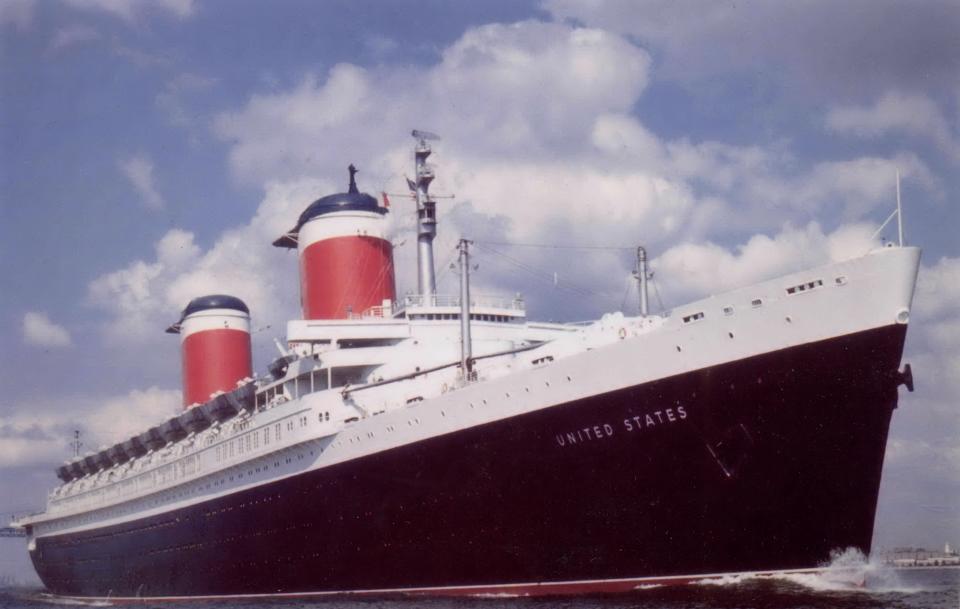
The SS United States ferried immigrants to new homes in America after the World War, and was fully racially integrated starting from its first voyage. The ship also played host to royalty, not just England's Duke of Windsor but also Duke Ellington of the United States. The future Jackie Kennedy plied her early journalism career aboard its decks, capturing the shipboard habits of aristocratic dogs. In sumptuous dining rooms, chef Otto Bismarck served specialties from poularde de Bresse to kangaroo tail soup.
If laid on its side, the 990-foot ship would be taller than any building in New Jersey or Delaware, and would also be the second tallest in Philadelphia — bested only by a recent Comcast tower that looks a little like a cigarette being pulled out of its pack.
Despite its literally Titanic size, the SS United States could outrun a torpedo in its day, said the ship’s caretaker, Ray Griffiths, a feat that made the ship as attractive to diplomats as it was to stars like Gary Cooper or Liz Taylor.
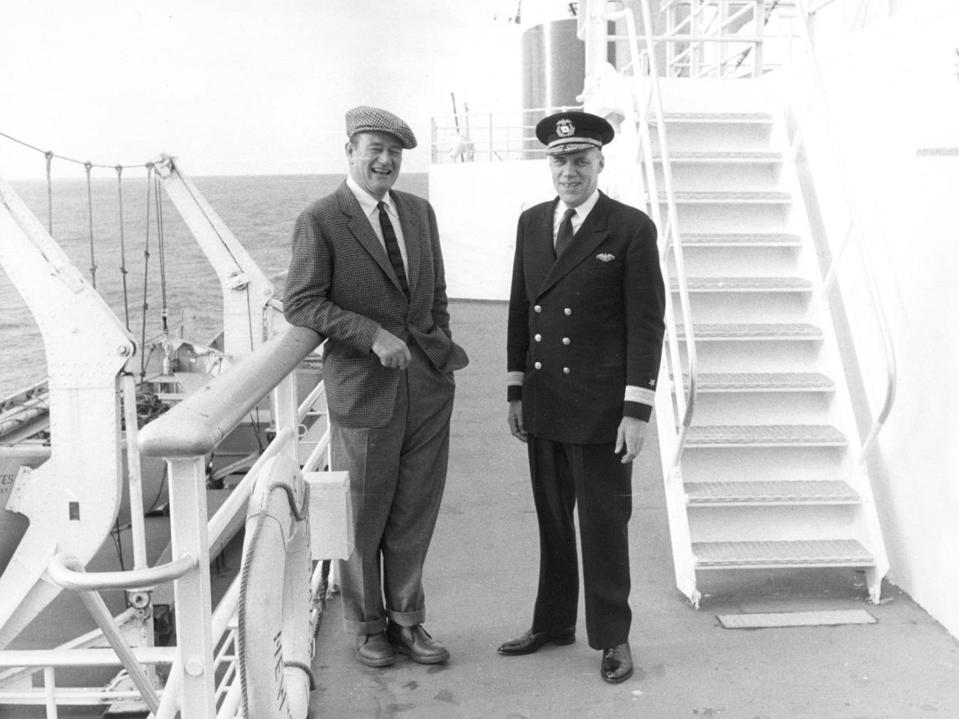
Indeed, aspects of the ship’s design remained state secrets during its early years. Its designer, William Francis Gibbs, was a legendary designer of Navy ships. The United States was built as a military-private partnership, which allowed it to transform into a military asset transporting 14,000 troops if the Cold War ever went hot.
“She's overbuilt. She's built like a Navy ship would have been from that era,” Griffiths said. “Mr. Gibbs combined almost all of his favorite types of designs and put it in the ship. He tried to iron out every potential weakness that he could come up with. And he did a terrific job. Everybody knows about the Titanic, right? It sank. That's why it's so famous. This ship did not.”
The lawsuit that threatens the SS United States' berth in Philadelphia
The unsinkable SS United States’ current troubles began on August 10, 2021, when a controller at Penn Warehousing sent a terse letter to the Conservancy, saying the ship had been in place for too long without a rent increase.
Henceforth, as of two weeks from that moment, the rent would double to $1,700 a day, said the letter, double the rate previously outlined in the lease.
The Conservancy instead continued to pay the previously agreed-upon rate rate of $850 a day, pending negotiations. According to the lease document presented to the court, their rent was due at that rate “until the vessel is removed from its current location.”
In March of the next year, Penn Warehousing filed a removal notice and then a lawsuit, citing back rent of more than $160,000. They asked the courts to eject the ship from Pier 82.
The Conservancy’s lawyers countered that the port operator had no provisions in the lease that allowed them to unilaterally raise rent — certainly not with two weeks notice during a pandemic — and that Penn Warehousing had taken this action to force the long-mothballed ship into financial duress, and out of the port.
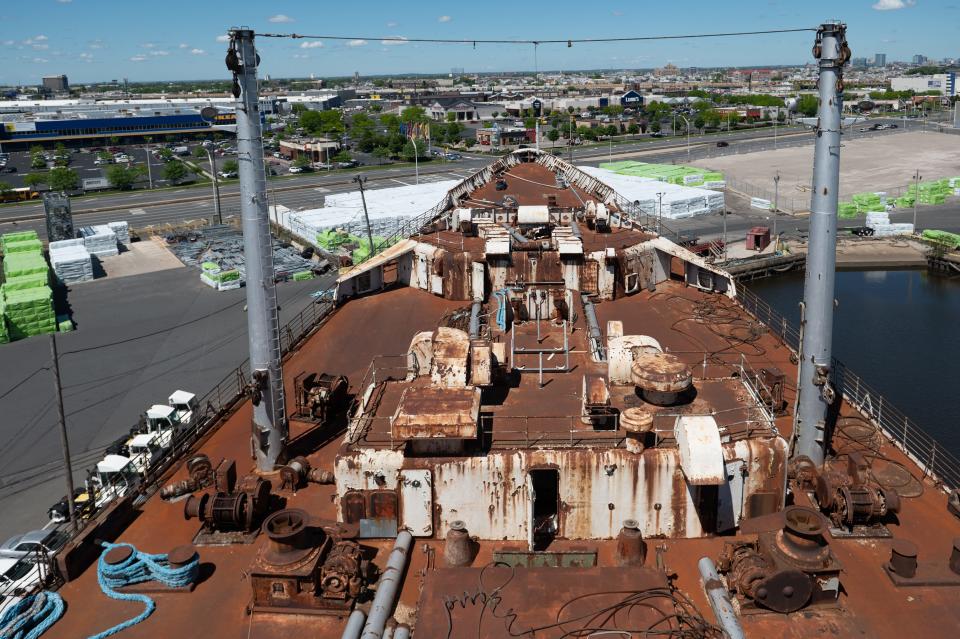
The facts of the rent dispute are not substantively in question: Lawyers for each side attached largely the same documents as evidence.
After the case for ejection in Pennsylvania was tossed on technical grounds, Penn Warehousing took it to federal court, where it now sits after multiple mitigation attempts failed. The trial is scheduled to go in front of a jury as soon as Sept. 18 of this year.
A troubled 50-year-history for the SS United States
This lawsuit is hardly the first existential threat faced by the SS United States in the last half-century.
America’s onetime flagship was put out of service in 1969, victim mostly to the rise of commercial airplanes. It now floats forlornly behind a security checkpoint in a working pier off South Philly’s Columbus Boulevard, a stately and unlikely presence looming over the drive-thru lines of a nearby Chick-fil-A.
The vessel passed like a cursed monkey’s paw from owner to owner in the decades since it went out of service. Each new possessor had visionary plans for the famed vessel. It would be, perhaps, a time-share cruise ship. A Hawaiian passenger liner. A floating hotel. A casino, an offshore entertainment complex or a hospital ship.
Each plan was scuttled. Time and again, the SS United States barely escaped the scrapyard.
In 1984, a debt-riddled Seattle developer stripped the ship hollow and auctioned “everything that was freestanding or could be unbolted from her interiors,” according to an article that year in the New York Times.
Peeling primer now hangs like stalactites from much of its interior. Rust mottles its outer hull, whose lower half shimmers with rainbow reflections when the light hits it just so. The ship’s famous red, white and blue funnels stand denuded.

The ship’s magisterial grand ballroom, its original dancefloor still intact, stands empty except for a bar constructed for a Colin Farrell action movie, "Dead Man Down," shot there in 2012.
All that remains of the ship’s first-class cabins are skeletal outlines on the floor. The vessel’s second-class bar is now in use only for fundraisers — a few beer bottles leftover from one such event stood scattered across a bartop on our May visit — or maybe the occasional shift drink by the skeleton crew who still keeps the United States in shape.
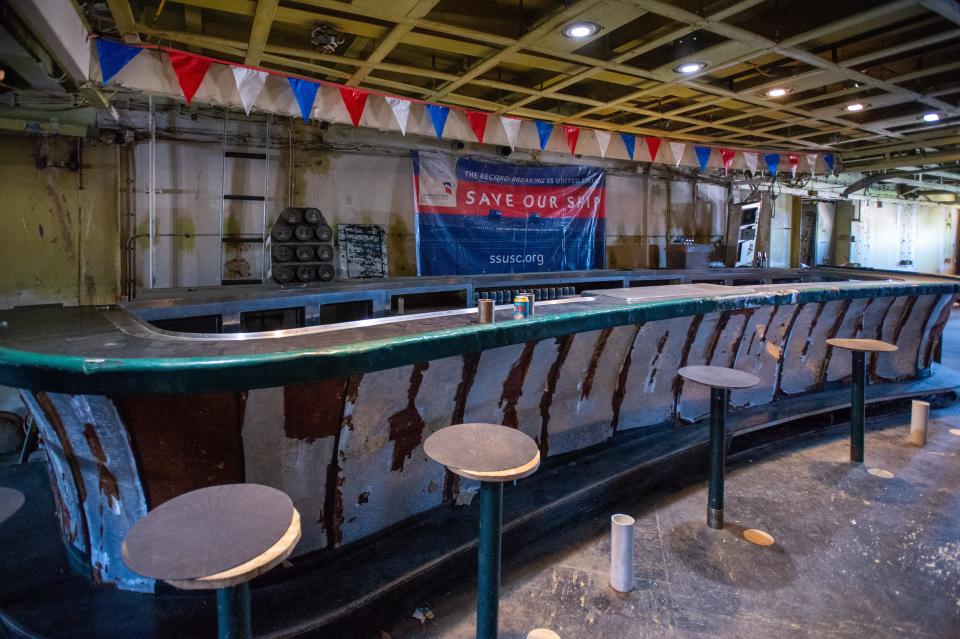
But whatever the ship’s cosmetic condition, said caretaker Griffiths, its “bones” are still good. The metal remains largely uncorroded. Even after being stripped, the ship is watertight after some careful maintenance.
Griffiths pats the ship with evident pride.
Former passenger Andrew Staroscik remembers playing ping pong there, as a 7-year-old Polish child whose family escaped the German invasion in World War II. His first awestruck vision of America was of the men who hosed down the ship in New York Harbor.
"I remember arriving in New York City, and the fire hoses shooting water," said Staroscik, now retired from a career at Bell Labs. "It was like you see in movies."
This May, he was thrilled to find that ping pong table still there, though covered in dust and missing its net, along cavernous sun-filled walkways where he remembers sprinting back and forth en route to his new country.
"Shame it's in such a state," Staroscik said, gesturing to the ship that to him once seemed impossibly large.
In 1992, after auctioning the SS United States' fixtures, that Seattle developer eventually had to surrender the vessel to U.S. Marshals.
The SS United States was towed by new owners to Turkey, and then to Ukraine where she was stripped of asbestos — before finally being left out in South Philly to rust like some character in a Springsteen song.
How the ship was acquired by the nonprofit SS United States Conservancy for preservation

South Philly is where Susan Gibbs first found her.
Her grandfather William Francis Gibbs, a product of Harvard but a native of Philadelphia, had dreamed since his youth of designing the world’s fastest ship.
He pledged himself to the sea while still a boy, upon seeing the launch of an large ship in South Philly.
“It was actually a lifelong obsession,” his granddaughter said. “He developed the first designs for a 1000-foot long, fast ocean liner back in 1914 or 1915. He dedicated his life to bringing this extraordinary ship into the world.”
In 1952 the SS United States became that masterpiece, the ship he’d dreamed of — a large passenger liner built with lightweight materials and designed to rigid military specifications, built to be both unburnable and unsinkable, with no wood on the ship that wasn't a kitchen butcher block or a piano.
“She's America's flagship,” Susan Gibbs said. “And she just personified the nation's competence and technological know-how and ambition after World War II.”
Her grandfather remained close to the ship, she said, calling the engineer and Commodore each day while the ship was at sea, and greeting it in New York when it came back home.
After she discovered a trove of old documents upon the death of her father in 1995, the SS United States became Susan Gibbs’s obsession as well.
The Conservancy she heads is a consortium of “maritime enthusiasts and historic preservationists” with donors from all 50 states and 40 countries, Gibbs said. A precursor group, in 1999, got the ship placed in the National Register of Historic Places, one of the youngest landmarks in the registry.
The Conservancy also made a believer out of billionaire Philadelphia philanthropist H.F. “Gerry” Lenfest, who ponied up $5.8 million in 2011 to help the nonprofit procure and preserve the historic vessel.
The SS United States' current stewards, like its past ones, have bold plans for the ship.
In 2018, they engaged developer RXR Realty and a host of naval designers, with plans to turn the ship’s more than 500,000 usable square feet into a floating hotel complex. Potential final destinations have included sites in Philadelphia, New York and Boston.
“The vision is a hotel, an event space — with really amazing food and beverage opportunities, as the developers like to call it,” Gibbs said. “Like a Mad Men-style lounge. As well as, of course, a Museum and Innovation Center.”
Though delayed by the pandemic, these ambitious development plans are now again making “significant progress,” Gibbs said.
What they need is a little more time.
Development plans for SS United States moving forward, amid obstacles
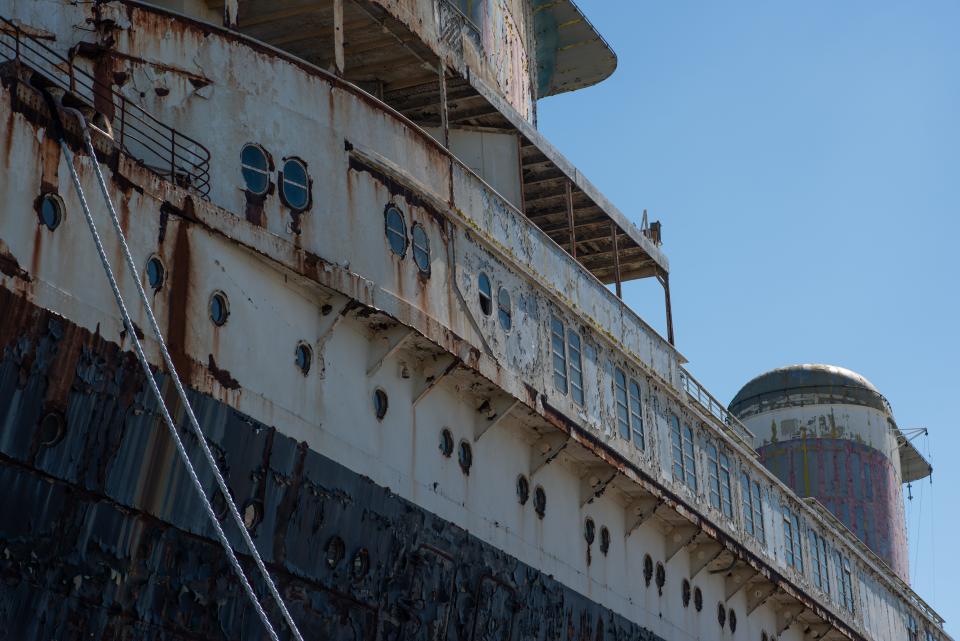
Time is expensive for a ship like the SS United States. And it is not limitless. With each day, the amount Penn Warehousing says the ship owes grows larger.
And the lawsuit might not be the only concern.
In July 2022, four months after Penn Warehousing's suit to eject the ship, the Port of Philadelphia unveiled a three-minute video outlining a bold new vision for the future, meant to revitalize the marine terminal on the Delaware River.
At Pier 82, where the SS United States sits, the agency’s video showed a bustling “Forest Products Center.”
A computer depiction of the SS United States, moored to its pier, disappeared in the agency’s vision of the future. As triumphant music played, the ship was boarded over by a broad and blank dock, upon which moved a fleet of lumber trucks that seemed made from Legos.
Whatever the results of the lawsuit, Gibbs knows the historic ocean liner has no permanent future at a South Philly pier walled off by security gates and closed to visitors.
Its current berth at Pier 82 was always meant to be temporary, Gibbs said.
The question is whether they can find a new home in time, and whether they’ll get the chance to do so on their own timetable.
The SS United States may be the fastest transatlantic ship ever built. But it is now unable to move under its own steam. Indeed, three of its large propellers are displayed at museums around the country.
Moving the ship even temporarily from its current berth would be not just time-consuming, but extremely costly. In 2015, facing insufficient funds, the Conservancy warned it might be forced to scrap the ship they’d charged themselves with preserving. That time, the donations came through.

“From the beginning, we have seen three possible paths for the vessel," Gibbs said, standing outside the ship she treasures, “Redevelopment as a stationary attraction, converting the ship into an artificial underwater reef or scrapping the vessel.”
She's confident there’s a path forward that doesn’t involve the grimmer two options, she said.
Gibbs points to the RMS Queen Mary, a British ocean liner with an equally troubled financial past, which just reopened to the public as a hotel and museum in California this spring. To the Queen Elizabeth 2, now a floating hotel in Dubai.
The SS United States can be “even better,” Gibbs said. With fixtures stripped, the ship has more possibilities for innovative design.
Representatives from RXR Realty declined to comment on the current state of development plans. But Gibbs believes the Conservancy can still save a ship she sometimes wishes she didn’t fall in love with so deeply — a vessel she sees not just as the work of her grandfather, but as a vision of America at its best.
A ship whose parts were built by people in all of the lower 48 states. An America not divided against itself. A country that worked together to accomplish something great.
She paused, suddenly, noting the reflections bouncing off the waves of the Delaware River and onto the sides of the ship: countless points of rainbowed light, dancing across the hull of the SS United States to music it seemed almost possible to hear.
“Look at it shimmer,” she said, smiling. “Isn’t it beautiful?”
Matthew Korfhage is a Philadelphia-based reporter for USA TODAY Network. Write him at mkorfhage@gannett.com or follow him on twitter @matthewkorfhage.
This article originally appeared on USA TODAY NETWORK: SS United States, larger than Titanic, sued for eviction in Philly

